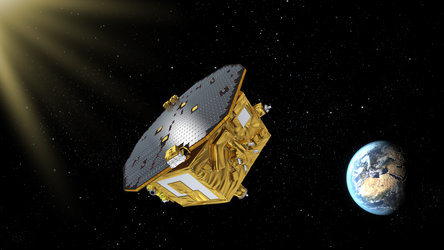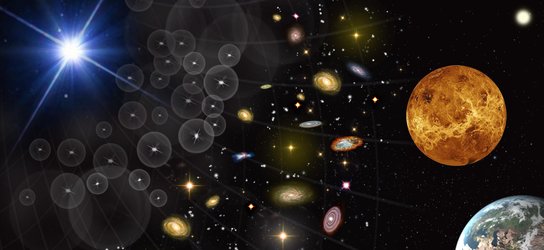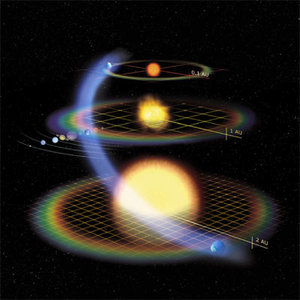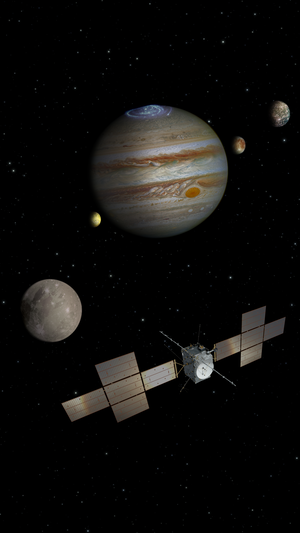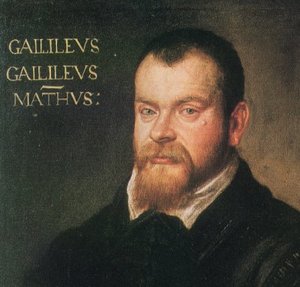Next step towards a gravitational-wave observatory in space
Yesterday, 25th of October 2016, ESA has invited European scientists to propose concepts for the third large mission in its science programme, to study the gravitational Universe.
A spaceborne observatory of gravitational waves – ripples in the fabric of spacetime created by accelerating massive objects – was identified in 2013 as the goal for the third large mission (L3) in ESA’s Cosmic Vision plan.
A Gravitational Observatory Advisory Team was appointed in 2014, composed of independent experts. The team completed its final report earlier this year, further recommending ESA to pursue the mission having verified the feasibility of a multisatellite design with free-falling test masses linked over millions of kilometres by lasers.
Now, following the first detection of the elusive waves with ground-based experiments and the successful performance of ESA’s LISA Pathfinder mission, which demonstrated some of the key technologies needed to detect gravitational waves from space, the agency is inviting the scientific community to submit proposals for the first space mission to observe gravitational waves.
“Gravitational waves promise to open a new window for astronomy, revealing powerful phenomena across the Universe that are not accessible via observations of cosmic light,” says Alvaro Gimenez, ESA’s Director of Science.
Predicted a century ago by Albert Einstein’s general theory of relativity, gravitational waves remained elusive until the first direct detection by the ground-based Laser Interferometer Gravitational-Wave Observatory and Virgo collaborations, made in September 2015 and announced earlier this year.
The signal originated from the coalescence of two black holes, each with some 30 times the mass of the Sun and about 1.3 billion light-years away. A second detection was made in December 2015 and announced in June, and revealed gravitational waves from another black hole merger, this time involving smaller objects with masses around 7 and 14 solar masses.

Meanwhile, the LISA Pathfinder mission was launched in December 2015 and started its scientific operations in March this year, testing some of the key technologies that can be used to build a space observatory of gravitational waves.
Data collected during its first two months showed that it is indeed possible to eliminate external disturbances on test masses placed in freefall at the level of precision required to measure passing gravitational waves disturbing their motion.
While ground-based detectors are sensitive to gravitational waves with frequencies of around 100 Hz – or a hundred oscillation cycles per second – an observatory in space will be able to detect lower-frequency waves, from 1 Hz down to 0.1 mHz. Gravitational waves with different frequencies carry information about different events in the cosmos, much like astronomical observations in visible light are sensitive to stars in the main stages of their lives while X-ray observations can reveal the early phases of stellar life or the remnants of their demise.
In particular, low-frequency gravitational waves are linked to even more exotic cosmic objects than their higher-frequency counterparts: supermassive black holes, with masses of millions to billions of times that of the Sun, that sit at the centre of massive galaxies. The waves are released when two such black holes are coalescing during a merger of galaxies, or when a smaller compact object, like a neutron star or a stellar-mass black hole, spirals towards a supermassive black hole.
Observing the oscillations in the fabric of spacetime produced by these powerful events will provide an opportunity to study how galaxies have formed and evolved over the lifetime of the Universe, and to test Einstein’s general relativity in its strong regime.
Concepts for ESA’s L3 mission will have to address the exploration of the Universe with low-frequency gravitational waves, complementing the observations performed on the ground to fully exploit the new field of gravitational astronomy. The planned launch date for the mission is 2034.
Lessons learned from LISA Pathfinder will be crucial to developing this mission, but much new technology will also be needed to extend the single-satellite design to multiple satellites. For example, lasers much more powerful than those used on LISA Pathfinder, as well as highly stable telescopes, will be necessary to link the freely falling masses over millions of kilometres.
Large missions in ESA’s Science Programme are ESA-led, but also allow for international collaboration. The first large-class mission is Juice, the JUpiter ICy moons Explorer, planned for launch in 2022, and the second is Athena, the Advanced Telescope for High-ENergy Astrophysics, an X-ray observatory to investigate the hot and energetic Universe, with a planned launch date in 2028.
Letters of intent for ESA’s new gravitational-wave space observatory must be submitted by 15 November, and the deadline for the full proposal is 16 January 2017. The selection is expected to take place in the first half of 2017, with a preliminary internal study phase planned for later in the year.
More information
http://www.cosmos.esa.int/web/2016-l3-mission-call
For further information, please contact:
Luigi Colangeli
Head of the Coordination Office for the Scientific Programme
European Space Agency
Email: luigi.colangeli@esa.int
Markus Bauer
ESA Science and Robotic Exploration Communication Officer
Tel: +31 71 565 6799
Mob: +31 61 594 3 954
Email: markus.bauer@esa.int















 Germany
Germany
 Austria
Austria
 Belgium
Belgium
 Denmark
Denmark
 Spain
Spain
 Estonia
Estonia
 Finland
Finland
 France
France
 Greece
Greece
 Hungary
Hungary
 Ireland
Ireland
 Italy
Italy
 Luxembourg
Luxembourg
 Norway
Norway
 The Netherlands
The Netherlands
 Poland
Poland
 Portugal
Portugal
 Czechia
Czechia
 Romania
Romania
 United Kingdom
United Kingdom
 Slovenia
Slovenia
 Sweden
Sweden
 Switzerland
Switzerland





























